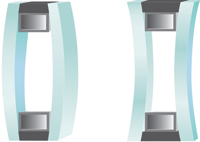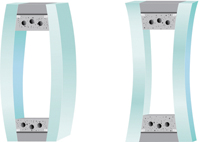
Technology
Insulating Glass
A guide to warm edge
Achieving environmental goals through advanced spacer technology
May 1, 2009 By Joe Erb
Do you feel like your approaching the point of Green burnout?
If you do, you are not alone. Environmental buzzwords topped many 2008
lists of words that should be banished from Queen’s English for either
being misused or overused.

|
|
| LEED GOLD certified PCL Centennial Learning Centre, Edmonton, Alta. Photos courtesy of Cohos Evamy and PCL: www.pcl.com |
Do you feel like your approaching the point of Green burnout?
If you do, you are not alone. Environmental buzzwords topped many 2008 lists of words that should be banished from Queen’s English for either being misused or overused. Familiar words and phrases such as going green, building green, greening, green technology, green solutions, and many other variations were included.

|
|
| LEED GOLD certified PCL Centennial Learning Centre, Edmonton, Alta. Photos courtesy of Cohos Evamy and PCL: www.pcl.com
|
Green is an extremely broad philosophy and nearly impossible to define. Some say changing your light bulbs to fluorescents and participating in a recycling program makes you green. Others take it much further by changing the way they eat, dress, travel, shop and remodel their homes.
Due to its vague definition, companies around the globe and in all market sectors have used and misused the words and concept of green (enough to be banished) to capture audiences. With so many companies on the bandwagon, how can you tell which products make a real difference and which are following a colour?
In building sciences, environmental terms like sustainability are much simpler to characterize because definitions and boundaries exist in the forms of laws, regulations and the Leadership in Energy and Environmental Design (LEED) Green Building Rating System. Although imperfect, LEED has well-defined parameters buildings need to meet for certification, including parameters for energy efficiency and sustainability.
LEED and other similar programs have changed the way architects and builders specify projects. Designing and building sustainable structures has created a resurgence in the demand for high-quality, high-performance building products that will stand the test of time.
In today’s world of tradeoffs and Value Engineering (VE) there are three prongs: quality, durability and price. The problem is that one or two of the prongs are often sacrificed at the expense of the other. So how do we get the best of all three? Sub-par building products sold on price alone are no longer acceptable in a world that is looking to preserve the environment for future generations.
Best practices for modern architecture include designing for energy savings now, energy savings for the long term and choosing products that will not end up in landfills long before their time – and that includes windows and window components.
 |
|
| Rigid spacer pumping action. Stress on the PIB Butyl and secondary seal can result in seal failure, potentially rejecting the Butyl in the sightline. |
|
 |
|
| Triple seal silicone foam spacer flexes with pumping action. PIB Butyl is contained between acrylic adhesive and sealant, preventing movement into the sightline. |
Opportunities for failure or success
Much has been written about windows and the way they affect energy loss in a building envelope. In simplest terms, windows are openings that create an opportunity for heat to transfer. It has long been recognized that windows, despite their propensity for losing energy, can serve as a valuable tool for saving energy.
Daylighting is the use of natural light through windows, skylights, light
shelves, and other tech-niques that supplement or replace electric lighting.
When implemented properly, daylighting can significantly reduce a facility’s lighting costs and overall energy usage.
Daylighting provides opportunities to meet today’s stringent energy regulations, but are window technologies up to the task of adequately reducing energy demand for the long term? With today’s improved Low-E and reflective coating technologies, it is increasingly important to ensure the edge seal technologies will preserve the integrity of the insulating glass (IG) unit.
For more than 40 years, rigid metal-based spacer technologies, such as aluminum and stainless steel, have been acceptable edge seal spacers. They served their purposes to separate the two panes of glass (typically clear over clear) in an IG window unit. Metal spacers are durable, but have two inherent problems that prevent them from being effective, long-term insulators.
First, metal is conductive and therefore facilitates heat transfer, giving windows the bad reputation of being energy wasters. New high-performance coatings and argon gas filling have helped offset some of these overall negative effects, but they do not solve the fundamental issues at the edge of glass.
Second, metal-based spacers are rigid. While this may sound like a positive for structural purposes, the rigidity of these systems do not allow for natural expansion and contraction of glass due to environmental factors, such as temperature changes, barometric pressure changes, snow loads and wind loads. The rigidity of these spacers can actually be a detriment to windows, creating sealant stress and stress cracks that ultimately lead to seal failure.
Recognizing the many shortcomings of aluminum and stainless steel spacers, the industry has seen numerous alternatives enter the marketplace over the years that used increasingly less metal, resulting in significant improvements in IG energy performance and long-term durability. With these technologies the term warm edge technology was coined. By definition, warm edge is any spacer that improves thermal performance over traditional “cold edge” aluminum spacers.
However, be cautioned that not all warm edge spacers are created equal. Some consider stainless steel spacers warm edge because the thermal performance is a little better than aluminum. Although this is a step in the right direction, it is not a significant step. Rigid metal-based systems still have the same shortcomings as traditional aluminum bar and tend to be more difficult to fabricate.
Flexible silicone foam IG
Advanced, flexible silicone foam spacers on the other hand provide significant improvements in thermal performance and provide the flexibility for natural expansion and contraction of glass in the field. The manufacturing process for flexible silicone foam IG is also streamlined dramatically. Reduced labour and increased output are benefits that the fabricator and the end user appreciate immediately and for the long haul.
However, some may still live under the misconception that it has to be metal to be strong. This simply is not the case. In fact, today’s flexible silicone foam spacers have demonstrated the strength needed to support the largest commercial IG, such as a four-sided silicone structural glazed curtainwall, in some of the most challenging climates around the world. The strength, performance and durability of these systems have been proven in the field for many years and through independent third-party ASTM E330 testing.
The technologies do exist to take full advantage of daylighting and windows are opportunities for success in terms of durability and energy savings. Architects and builders should seek window systems that incorporate flexible, silicone spacer technologies. When compared to aluminum, flexible silicone spacers provide the follow advantages:
- reduced sealant stress for long-term durability
- contribution to LEED Certified Projects for Energy and Atmosphere credits
- warmer sightline – up to 16 F/8.8 C, for significant condensation resistance
- improved U-Value by up to 12 per cent for significant energy savings
- noise reduction by up to 2 dB
Any way you look at it, to achieve optimal thermal performance, long-term durability and sustainability, reducing metal in the IG is a necessity.
Warm edge has gained wide acceptance in the residential building market since 1991 when only 15 per cent of IG manufacturers had adopted the technology. Today, that acceptance rate has risen to more than 90 per cent.
Awareness in the commercial segment is steadily growing as well. The continued focus on achieving LEED certification has quickly furthered efforts to promote high-performance glazing. The number of jobs that are being specified for warm edge technology is increasing daily in the commercial market. Warm edge has also been written into the master spec for LEED projects in a growing number of architectural firms.
Regardless of whether you like the word Green, remember there are technologies that can and will make a difference today, tomorrow and for generations to come. With the dynamics of technology today, true warm edge is just the beginning. The industry should embrace the changes that work and build with the next generation in mind.
*Joe Erb is a product manager for Edgetech I.G., specializing in the company’s commercial products. Erb has worked in the fenestration industry for more than 14 years and regularly speaks to architects about warm edge technology and high-performance through the AIA’s continuing education program and other architectural forums. He can be reached at jerb@edgetechig.com. To learn more about warm edge technology in achieving LEED certification, visit www.edgetech360.com .
Print this page